Table of Contents
With their elegant white stems (shanks) and a cluster of lush green leaves cascading down, leeks – an onion family member – are a pleasing and widely cultivated crop.
Leeks generally take 4-5 months to reach maturity, which tends to be in the autumn and winter seasons when there’s less fresh produce of other crops available. There are various varieties of leeks available.
For instance, for harvesting in summer, you can opt for baby leeks. They have a delicious, sweet onion flavour. They are good for brazing, cooking, or roasting. Whereas mature leeks are more nutritious.
Don’t worry; we’ve covered everything in this blog post to ensure the growing Leeks UK.
How to Grow Leeks in a Vegetable Garden
March is considered the main month for sowing leeks. However, you can sow earlier or later, depending on the variety and your local climate. You can plant them out from May and harvest them through fall and winter.
How to Grow Leeks from Seed
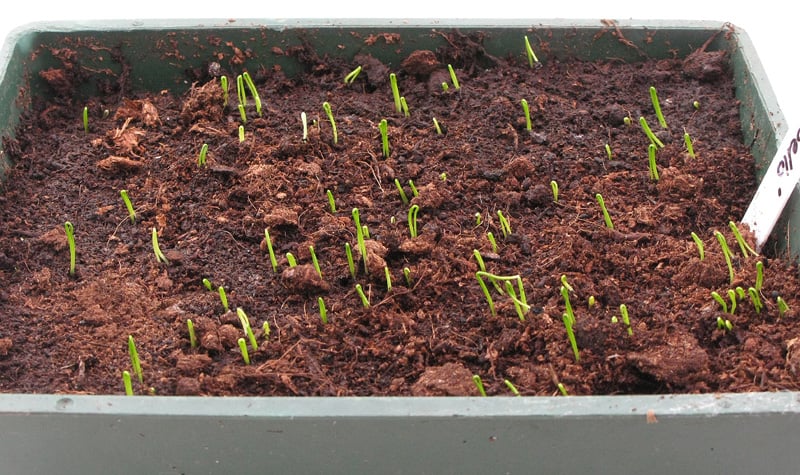
To ensure successful growth, it’s important to plant leeks in a sunny area with soil that is both rich in nutrients and drains well. Leeks can flourish in a variety of settings, whether it be in a traditional garden bed, raised bed, or even tall containers. Choose the setup that works best for your needs, and properly space your leeks by planting them six inches apart.
Sowing seeds successively over several weeks can provide you with a consistent and ongoing supply rather than an excessive amount at once. Depending on whether you have early or late varieties, you’ll need to sow at different times. Thus, it’s important you check the seed packet before planting.
If you want to grow leeks from seeds, use small pots or seed modules filled with potting mix that has a fine tilth. It’s also worth considering seed compost as an alternative.
- Start by planting one seed per pot or module and lightly covering it with potting mix.
- Keep the soil moist but not excessively wet.
- It typically takes up to two weeks for the seeds to start germinating.
- Once your seedlings reach a height of 6–8 inches, they can be planted outside in the early summer.
- For planting seedlings, use a dibber or pencil to create 6-inch-deep holes spaced approximately 6 inches apart in rows that are around 12 inches apart.
- Take out the leeks from their pots, cut their roots to approximately 2 inches long, and cautiously place one in each hole.
- Covering the stems in this manner will cause them to be blanched, resulting in a sweeter and whiter taste.
- Fill the holes with water, but avoid filling them with soil. As your leeks mature, you may need to adjust the soil around the base, but be mindful not to let any soil fall between the leaves and get caught in the layers.
- You must give your leeks liquid fertilizer every 3–4 weeks.
- If you prefer small and tender leeks, then you should harvest them during late summer, but you can also opt to do so during fall or winter.
- If you allow a portion of your leeks to bloom, then they can provide you with seeds for the following year, though it’s important to note that the offspring may not exhibit the same traits.
- If you want to sow your seeds directly, use a dibber to plant each seed about 8 inches deep. If you want to achieve a successful direct outdoor sowing of leeks, warm soil is a must. This is especially significant when dealing with thick clay soils that take a while to warm up. If you’re aiming for early crops, try covering your plot with black or clear plastic sheeting two weeks in advance of sowing. Ensure that the soil temperature is at least 45°F (7°C).
How to Grow Leeks in Pots
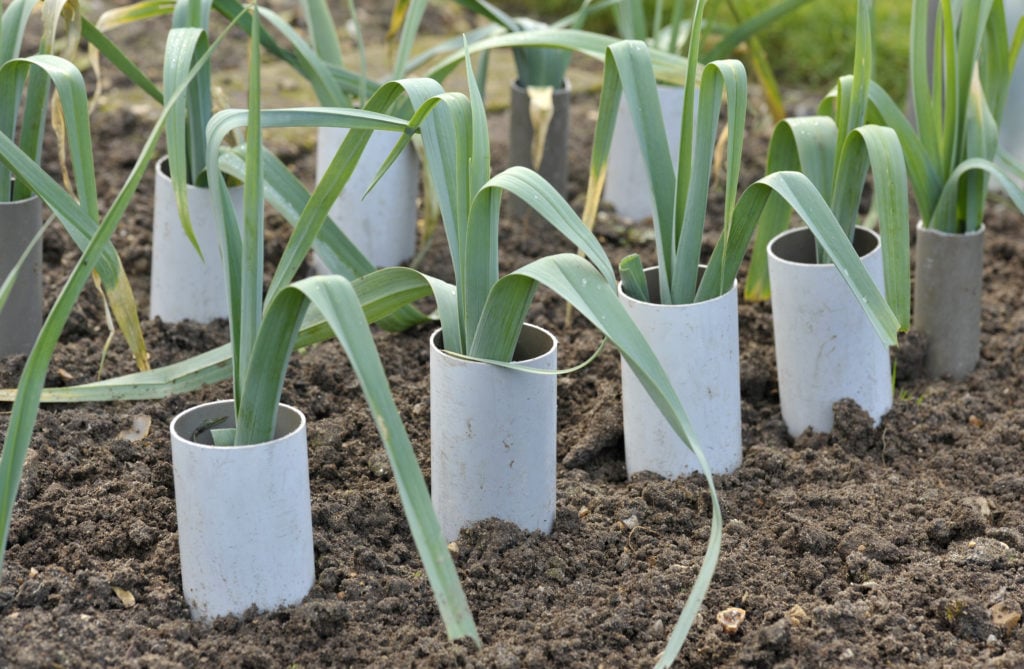
Leeks make a perfect addition to your container vegetable garden. If you want easy access to freshly-grown produce for cooking, try planting them in pots on your patio or balcony. For optimal growth, you need to select a pot that is 12 inches in diameter and has plenty of depth. If they begin to encroach on each other’s space, you can thin them out later on and use the thinning to prepare some delicious snacks.
To start off, make sure you plant the seedlings deep and use water to fill the hole instead of the soil. This will aid in the roots taking hold and settling in. Make sure to add some texture to the composted potting mix, as adequate drainage is essential for cultivating winter crops.
Keep in mind that planting leeks in pots can result in a larger yield if you place them closer together, with a distance of about 2 inches between each plant, and start harvesting them while they are still young.
Plant Care Tips for Leeks
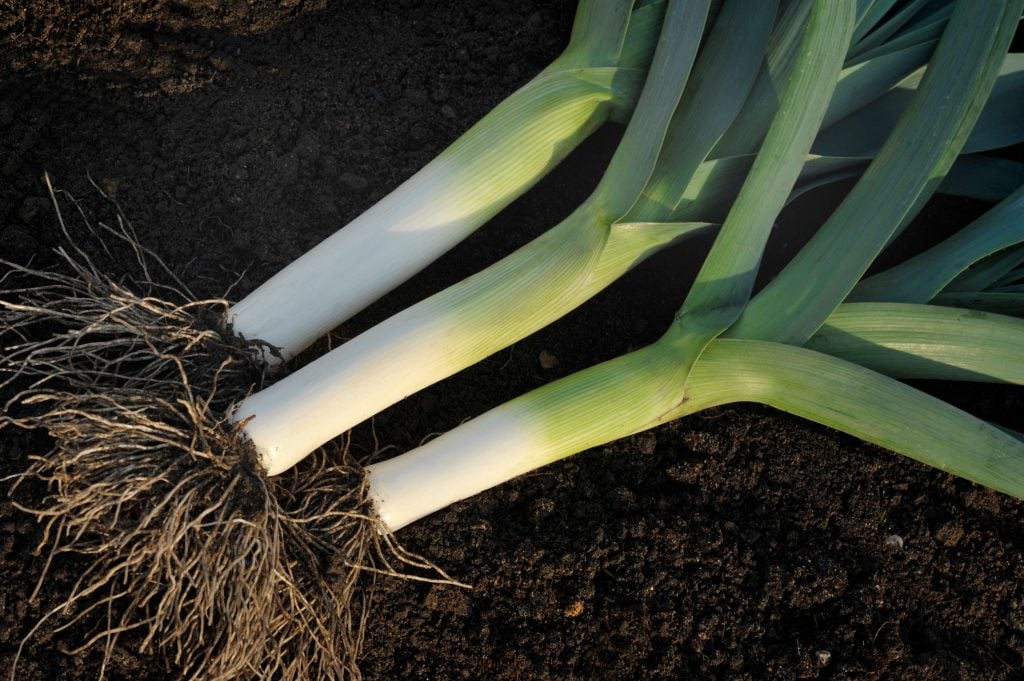
There are several ways to tend to leeks. Once leeks are growing strong, you must weed them regularly, water them during dry spells, and ‘earth them up’. This involves heaping dry soil around the plants, which causes them to turn white and grow a long, distinctive shank. Repeat this action multiple times as the plant grows, but be mindful not to let any soil collect between the leaves.
1. Watering
It is important to water leek seedlings and young plants consistently to promote healthy growth. Subsequently, you should only have to water during the dry season, every two weeks until the next rainfall. Leeks in containers will need regular watering throughout the season, as the compost will dry out much more quickly. If you want to avoid fungal ailments like leek rust, it’s important to manage overhead watering.
2. Mulching
If you want to keep the soil around your leek plants moist, you must apply a thick layer of mulch, such as well-rotted manure or garden compost. This also helps prevent weed growth.
3. Weeding
It is essential to weed frequently to prevent young leeks from competing for light, water, and nutrients. Weeds have an easy time growing around leek foliage since it doesn’t cast much shade, which can swiftly affect and hinder the growth of the plants.
4. Protecting from pests
A good way to prevent Onion thrips, Onion maggots, and Allium leaf miners from ruining your growing leeks UK is by using insect-proof mesh to cover them and keep them away.
How To Harvest Leeks
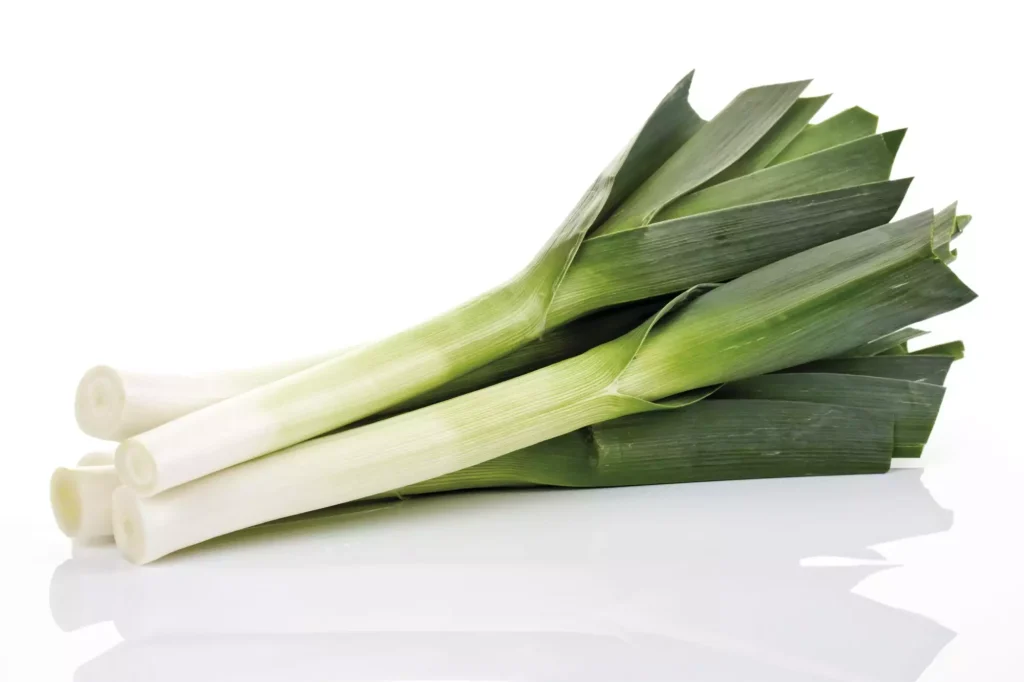
If you want to keep your Leeks fresh, you should harvest them as and when you need them. If the soil is loose, you could simply pull the leek out by hand. Otherwise, you could use a fork to loosen the roots and carefully lift the leek upward.
One of the best things about leeks is that they can be harvested when they are young and tender, and the plants can keep growing throughout the winter, remaining in their position until they’re needed.
It’s possible to harvest leeks of any size, with baby leeks taking only a few months and mature leeks taking up to four months or more. Harvest the produce early on, when it is still small, generally towards the end of summer, to prolong the cropping period. By picking every other leek in the row, you can allow the remaining ones to grow bigger.
To remove the plants from the soil, simply use a fork to lift them gently. If you have hardy leeks, they can withstand the cold winter and spring weather and can be harvested on an as-needed basis.
Prior to cooking, cut the leeks lengthwise and rinse them under running water to remove any soil that may be hiding between the leaves. Cook them with care, as they can quickly burn and develop a bitter taste. You can steam, sauté, or roast these versatile vegetables, and they taste great with cheese sauce. They’re also perfect for leek and onion soup, casseroles, and countless other dishes.
If you notice your leek plants flowering (bolting), it’s best to remove the stalk promptly while the bud is green and tightly closed. These tender flower buds, referred to as scapes, are good, whether served raw or lightly cooked, and are commonly compared to asparagus due to their subtle flavour.
How to Store Leeks
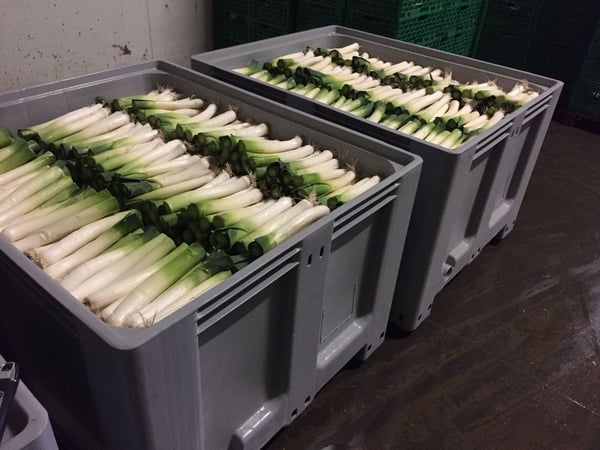
To store your leeks for a week, simply place them in an airtight plastic bag and keep them in the fridge’s crisper drawer. If you want to store leeks for a longer time in colder zones, make sure to extract them from the ground with their roots attached. Trim the leaves until only one inch of green is left on each one. Put the stems in a box, making sure that the root side is facing downwards. Fill the box with clean sand, sawdust, or vermiculite. Store the packaging in a cool area and keep it damp. You can expect these items to remain fresh for 8 weeks.
If you want to freeze leeks, start by washing them, slicing them, and blanching them for a minute in boiling water. After which, drain them, drip-dry them, and toss them into plastic freezer bags. You can add frozen leeks to soups, stews, and other dishes.
Conclusion
In conclusion, Leeks are versatile plants that can be grown effortlessly for personal or commercial use. Planting leeks in the spring and providing them with proper watering and care will reward you with a tasty and aromatic allium flavour to add to your autumn and winter meals.
The Greeks, Romans, Welsh, and Irish had a good reason for liking leeks! These plants require low maintenance in the garden, take up minimal space, can withstand very cold winters, and can be used in a wide range of recipes.
When are you planning to start growing leeks?
Frequently Asked Questions
How Long Does It Take to Grow Leeks?
Leeks thrive in cooler temperatures and are considered a long-season crop, requiring an average of 85 to 120 days to mature. Planting them in the spring and harvesting them during the fall yields the best results.
What Month Do You Plant Leeks?
To ensure a good harvest, it is recommended to plant mid-season and late-season leeks in early spring. You can start indoor seeding about 12 weeks prior to your last expected frost date, typically falling between January and March in most regions.
Do Leeks Grow Back Every Year?
Despite being typically grown as annuals, leeks are actually hardy perennials or biennials. They have the capability to grow back the following year, expanding into a cluster of bulbous lateral growths that can be harvested indefinitely.
Can You Eat the Leaves of Leeks?
Every part of the leek plant is edible. The leaves of leeks possess a sweet and mild flavour similar to that of the white portion of the stem. Their texture can be somewhat tough, so it’s best to slice them thinly or sauté them. The darker green parts of leek leaves are also commonly used in soups and stocks.

![Learn How to Grow Leeks: From Seed to Harvesting [UK] How To Grow Leeks In A Vegetable Garden](https://www.thearches.co.uk/wp-content/uploads/How-To-Grow-Leeks-In-A-Vegetable-Garden.jpeg)



